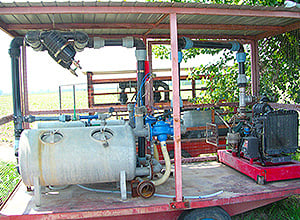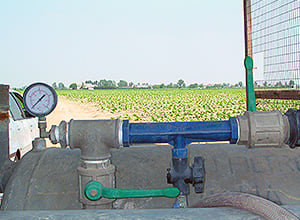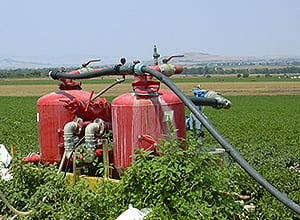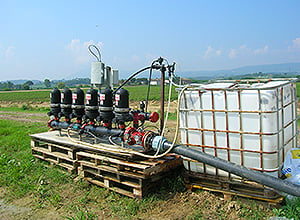News
Drip Irrigation and Fertigation: which advantages do they bring to crops?
News _ 9 June 2021
In the last years, climatic change (in particular, the extreme raise of temperature and the lack of rainfalls in summer) became a serious problem everyone must deal with, especially farmers which are forced to adapt their crop to these conditions.
To irrigated crops, must be applied water-saving irrigation techniques, improving water and electricity/fuel use (for irrigation plants’ functions) as well as the use of fertilizers. We are talking of micro-irrigation or drip irrigation in easier terms; this technique allows to reach very important objectives such as high-efficiency use, even irrigation and low water pression.
Its correct application can also bring other advantages, such as an increase of both yield and crop quality. Furthermore, with fertigation technique (distribution of fertilizer together with water), the advantages brought by drip irrigation are enhanced by the possible automation of the operations. Let’s discover more in this article!
.jpg)
Differences between sprinkling and micro-irrigation
For extensive cultivation (such as corn, industry tomato, tobacco, potato, fruits and vegetables in general, etc…), with mainly springtime-summertime cycle and mostly in light and sandy soils, irrigation and fertilization are crucial. However, there’s still a lot of work to do concerning the management of both irrigation and fertigation, in order to optimize the hydric and mineral nutrition of nutrients brought by water-soluble fertilizers.
The widespread use of big machines for sparkling irrigation, although their constantly improved technical and reliability characteristics, they still suffer high management costs. Such machines in fact require an important amount of manpower and energy, which are necessary to distribute huge quantity of water at high pressure, sometimes higher than 8-12 atmospheres.
 Since water resource is getting less and less available, its consumption has to be strictly managed and controlled, using both drip irrigation systems and automation through sensors, wasting less water (higher water saving) and optimizing its utilization efficiency. Drip irrigation technique, combined with fertigation, allows a hydric stress reduction to the plants for all the crop cycle, helping them to find water and nutrients easily and in proper quantities. The accuracy of nutrition control is not easy to apply in case of crops irrigated by sprinklers; on the contrary it’s easier in case of crops irrigated by drip irrigation. As consequence, precision fertigation is a logical application of micro-irrigation.
Since water resource is getting less and less available, its consumption has to be strictly managed and controlled, using both drip irrigation systems and automation through sensors, wasting less water (higher water saving) and optimizing its utilization efficiency. Drip irrigation technique, combined with fertigation, allows a hydric stress reduction to the plants for all the crop cycle, helping them to find water and nutrients easily and in proper quantities. The accuracy of nutrition control is not easy to apply in case of crops irrigated by sprinklers; on the contrary it’s easier in case of crops irrigated by drip irrigation. As consequence, precision fertigation is a logical application of micro-irrigation.
The leaves which get wet with sparkling irrigation are an easy target for diseases provoked by fungus and bacteria. But that’s not all: when the soil gets constipated by the beating fall of water done by sparkling irrigation, the superficial crust appears (in particular, in presence of loamy soil) and it could obstacle the growth of new-born plants. Especially such soil compaction, if prolonged for several days, may cause radical asphyxia to young plants, also in case of transplant, provoked by low level of oxygen which reduces roots’ growth and plants’ development as consequence. The water, if distributed slowly and in fractionated quantity won’t determine soil erosion and problems related to the superficial flow.
Thanks to micro-irrigation technique, it will not be necessary to create channels for the sprinklers, gaining in this way a large portion of field destinated to the cultivation. Furthermore, the wind won’t obstacle the irrigation process and other crop operations can be performed while drip irrigation is active. There are however some disadvantages in micro-irrigation: for example, the t-tape pipe has to be collected and discarded at the end of the cultivation cycle. In case of deeper position of the pipe (30-35cm) however, such action is not necessary since in sub-irrigation, the pipe will remain in the soil for many years.
How does a fertigation plant work in open field?
The number of irrigation sectors is linked to the flow rate of the irrigation plant, to plants’ exigences and to the total area to be irrigated. The availability of equipment and well-designed plants, added to the proper technical knowledge of the planner, allow to the farmer to get a high-efficiency plant granting hydric uniformity.
 Of course, water filtering and fertilizing processes as well, have to be adapted to the flow rate of such plants. Such choice is based on technical, economical and functions calculations: through these plants in fact, the farmer can easily manage up to hundreds of hectares, even in extreme hydric emergency conditions due to a high evaporation or in sandy soils. Filtration and fertilizer injection can be performed thanks to adapted structures which can be linked to the tractor using a 3 point linkage or moved by wheels, in order to be used and repositioned in different areas of the farm to cover more surface to be irrigated, using just a single automation and control unit.
Of course, water filtering and fertilizing processes as well, have to be adapted to the flow rate of such plants. Such choice is based on technical, economical and functions calculations: through these plants in fact, the farmer can easily manage up to hundreds of hectares, even in extreme hydric emergency conditions due to a high evaporation or in sandy soils. Filtration and fertilizer injection can be performed thanks to adapted structures which can be linked to the tractor using a 3 point linkage or moved by wheels, in order to be used and repositioned in different areas of the farm to cover more surface to be irrigated, using just a single automation and control unit.
For years, irrigation companies have been supplying irrigation and fertigation management systems at low cost and completely automated: such systems, being carried by a tractor or pick-up, can be quickly installed and powered by continuous current with the only recommendation of choosing alike fields concerning flow rate and number of sectors. In this way, several hectares can be managed in two, three or more different sectors
Components of the fertigation plant
A well-designed irrigation plant for specialized crops is composed first of all by a filtering system, possibly automatic, able to clean itself when the pressure values are not stable, which indicate that there’s an accumulation of dirt inside the filter.
 A good self-cleaning filter must be able to perform a counter-washing action, with minimal flow rate reduction and in short time. In a few minutes in fact the plant must be able to work even with very dirty water, letting the farmer free from any cleaning procedure. An electrovalve operated by control unit will manage both irrigation and filtration, starting up the plant at the decided day and hour, activating at the same time also the main pump group, which collects the water from the source and send it to the hydric plant at variable pressure, according to plant’s dimensions and type. In case of already pressurized water (irrigation consortium) it’s sufficient to link the system to the selected output, controlling the opening and closing of the valve.
A good self-cleaning filter must be able to perform a counter-washing action, with minimal flow rate reduction and in short time. In a few minutes in fact the plant must be able to work even with very dirty water, letting the farmer free from any cleaning procedure. An electrovalve operated by control unit will manage both irrigation and filtration, starting up the plant at the decided day and hour, activating at the same time also the main pump group, which collects the water from the source and send it to the hydric plant at variable pressure, according to plant’s dimensions and type. In case of already pressurized water (irrigation consortium) it’s sufficient to link the system to the selected output, controlling the opening and closing of the valve.
The control unit will operate both opening and closing of the electrovalves, directing the water to the selected irrigation sector and controlling, with a flowmeter, both water distribution and fertilizer injection. In case of flow defects (probably broken pipes) it’s possible to stop the irrigation and activate an alarm, avoiding any damage to the crop. The control unit can also manage the fertilizers’ injection (previously melted in specific tanks) handling the quantity of non-fertilized water, in order to humidify the selected zone helping plants’ roots to absorb the nutrients. After that, it’s possible to distribute the fertilizing solution, using a dedicated flowmeter to get the correct volume/volume ratio, according to the indications supplied by the technician.
The best results in fact are obtained with a content of fertilizer in the nutritive solution which has to be no more than 1-2 grams/lt, considering also the nutrients (cation and anion) already present in the water. In the same way, it’s possible to correct the pH of irrigated water, achieving an optimal valor of pH 6-6,5 through a proper acidification.
 When the fertilizer fill is completed, the control unit can finish the irrigation process with the remaining part of acidified water, preventing the risk of incrustation of drippers provoked by limestone, before the next irrigation cycle. Such operations are repeated for all the irrigation sector. In any moment, the farmer can control the effected irrigation through the control unit, following some simple operations. Of course, it’s also possible to control the system manually, through computer or smartphone/PC. In case of “movable system”, when the irrigation is ended, it can be quickly detached from the connections thanks to quick spherical joints, linked to the tractor or pick-up and finally stored in the warehouse, avoiding any trouble connected to theft and act of vandalism.
When the fertilizer fill is completed, the control unit can finish the irrigation process with the remaining part of acidified water, preventing the risk of incrustation of drippers provoked by limestone, before the next irrigation cycle. Such operations are repeated for all the irrigation sector. In any moment, the farmer can control the effected irrigation through the control unit, following some simple operations. Of course, it’s also possible to control the system manually, through computer or smartphone/PC. In case of “movable system”, when the irrigation is ended, it can be quickly detached from the connections thanks to quick spherical joints, linked to the tractor or pick-up and finally stored in the warehouse, avoiding any trouble connected to theft and act of vandalism.
Conclusion
Drip irrigation and fertigation can bring huge benefits to farmers, avoiding problems related to soil fertility and its yield, but also related to plants’ development. Of course, high-performance irrigation plants have to be joined by proper soil preparation machinery as starting phase, which can grant a well-prepared soil ready to host the cultures.
Since decades, Forigo creates innovative solutions for agricultural and horticultural sectors, with a special attention to the customization of the machine, satisfying every customer’s needs. Our competence and experience are always at your disposal: for more info concerning drip irrigation and fertigation and get a deeper knowledge of our solutions, do not hesitate to contact us!

Research and Development Division of Forigo Roteritalia. Team of experts engaged in the study and analysis of the main agricultural and horticultural techniques used today. Knowledge combined with competence are the starting point for continuous improvement in a scenario of innovation and technological development.
Upcoming Exhibitions
18 December 2019
Orticoltura Tecnica in Campo – XVII edition
Previous Exhibitions
16 April 2019
Enovitis 2019: innovation in viticulture


















